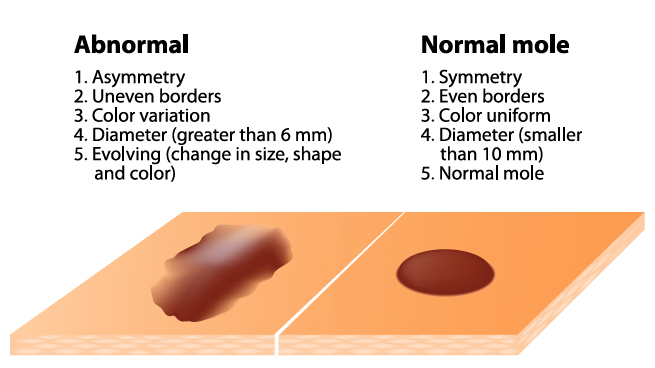Moles: What to Look For and When to Worry
Moles: What to Look For and When to Worry
By Unknown
Updated
5 minute read
Different Types of Moles
Moles are generally small, pigmented spots on the skin. Moles come in many shapes, sizes and colors. Moles can be raised off the skin or flat. There is a huge variety in the types of moles that a person can have. Moles are classified generally into the following categories:
- Congenital moles. Moles that are present at birth are called congenital moles. Congenital moles are categorized by their size: small, medium and large. Only large congenital moles (greater than 20mm in size) have a significantly increased risk of turning into a skin cancer.
- Acquired moles. Most moles are acquired, meaning they develop after birth. They are typically smaller than a pencil eraser and have even pigmentation and a symmetrical border. Most acquired moles will not develop into a skin cancer.
- Atypical moles. Atypical moles (also called dysplastic nevi) have asymmetrical, irregular borders and often have multiple colors. The pigmentation is often uneven and they can have focal darker areas. Multiple atypical moles can run in families. The more atypical moles that you have, the higher your risk of skin cancer.
When to See Your Doctor About Your Mole
It is important to consult your doctor about any suspicious moles, as these lesions may represent malignant melanoma, a life-threatening type of skin cancer
Examine your skin every month or two to look for any new or changing moles. If you have a family history of atypical moles or skin cancer or you have numerous moles, you may benefit from seeing a dermatologist for regular skin checks.
When you examine your moles, remember the ABCDEs of melanoma. If you notice any of the following, consult your doctor or dermatologist:
A for asymmetry: A mole in which one half of the mole does not look like the other half
B for irregular border: A mole with a poorly defined or scalloped border
C for varied color: A mole with multiple shades of black, brown, white, red and/or blue
D for large diameter: A mole that is larger than a pencil eraser in size
E for evolving: A mole that is changing in size, shape or color
New moles: A new mole that develops, especially if it appears after your 30s
Bothersome moles: A mole that bleeds, itches or is painful
RELATED: Skin Cancer Basics
Removing a Mole
Most moles are harmless. However, if your dermatologist is concerned about one of your moles or you want a mole removed, this can usually be done easily in the clinic.
To remove a mole, your dermatologist will numb the area around the mole and shave or cut it off. Sometimes a few stitches are required. The tissue will be sent to a laboratory to confirm it is not cancerous.
Keep an eye on your moles. The earlier a skin cancer is detected, the easier it is to be treated.
